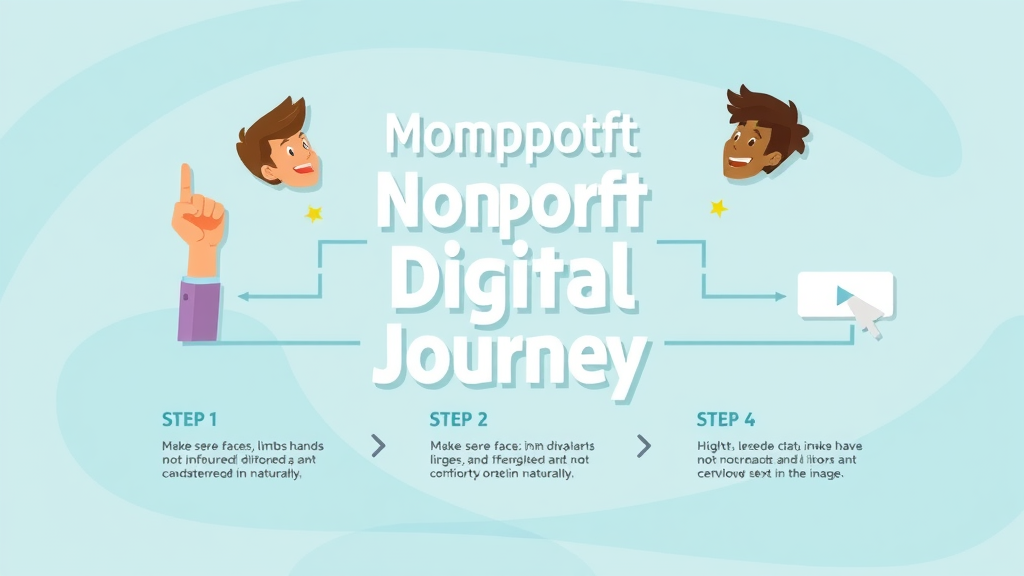Introduction: Why Every Nonprofit Needs a Robust Nonprofit Digital Strategy
Did you know that nonprofits with a well-defined digital strategy raise, on average, 36% more donations each year? Today’s nonprofit landscape isn’t just about passionate stories or worthy causes—it’s about finding your community online and inspiring them to take action. In the age of digital transformation, nonprofits must adopt a proactive nonprofit digital strategy to reach supporters, raise awareness, secure funding, and advance their missions. Failing to engage and grow your online presence means missing out—not just on donations, but on powerful opportunities to drive real change in your community.
"Did you know that nonprofits with a well-defined digital strategy raise, on average, 36% more donations each year?" — Nonprofit Tech for Good

The Digital Transformation of the Nonprofit Sector
The nonprofit sector has undergone a dramatic digital transformation in recent years. Organizations are quickly discovering how important digital marketing, social media engagement, and a strong online presence are for connecting with their audience and expanding their impact. With donors and volunteers spending significant time on digital platforms, a thoughtful digital strategy is no longer just an asset—it’s a necessity. Whether your nonprofit is just starting or evolving, embracing a digital-first mindset sets the foundation for greater reach, streamlined operations, and enhanced audience engagement. Digital transformation isn’t just about new tools—it’s about changing how nonprofits build relationships and drive change in a connected world.
As digital maturity increases across the sector, understanding the latest nonprofit digital strategies and leveraging technology has become the fulcrum for long-term sustainability. From shifting fundraising goals to developing dynamic content, digital strategies offer the flexibility and innovation nonprofits need to overcome traditional challenges. Using social media, email marketing, and data-driven storytelling allows organizations to track impact in real time and make informed decisions. In this comprehensive guide, you'll learn how to craft a nonprofit digital strategy that turns aspiration into action and impact.
Unpacking the Essentials: What You’ll Learn About Nonprofit Digital Strategy
- How to develop a nonprofit digital strategy from the ground up
- Tactics for digital marketing, social media presence, and email marketing tailored for nonprofits
- How to leverage digital transformation and digital maturity to maximize impact
- Key digital tools and free resources for nonprofits

Defining a Nonprofit Digital Strategy: Scope, Benefits, and Core Principles
What is a Nonprofit Digital Strategy?
A nonprofit digital strategy is a comprehensive plan that guides nonprofit organizations in leveraging digital channels, tools, and tactics to achieve their core mission and maximize impact. This digital roadmap prioritizes goals such as increasing online engagement, boosting fundraising, expanding volunteer networks, and effectively communicating the organization’s why. Unlike a business-focused marketing strategy, a nonprofit's digital strategy often centers around amplifying cause awareness rather than profit. It aligns with overarching campaigns and considers audience segmentation, digital content, digital marketing tactics, and the unique constraints of the sector. Developing a digital strategy means identifying which areas of digital transformation—such as data analytics, content creation, or digital fundraising—will bring the most benefit to your mission.
It's about making informed decisions that best use your resources while adapting to the constantly evolving online environment. A strong digital strategy will support brand visibility, deepen donor relationships, facilitate two-way communication, and ultimately ensure your nonprofit is resilient and future-ready. The core principles remain flexibility, authenticity, sustainability, and impact measurement—values that lay the groundwork for ongoing digital success and growth.
Benefits and Impact of Digital Transformation for Nonprofits
Digital transformation empowers nonprofits to break through traditional barriers. By shifting to digital platforms, organizations streamline communication, reach new audience segments, and make the donor experience seamless. A nonprofit digital strategy helps you respond quickly to community needs, pivot during crises, and take advantage of the latest marketing strategies. Importantly, digital maturity means collecting data on engagement and outcomes, so you can continuously refine your strategy for greater results.
Digital transformation also unlocks efficiency. Managing campaigns, automating routine tasks, and incorporating new digital tools allows teams to focus more on their core mission. As digital channels become the primary space for interaction, nonprofits equipped with the right behind-the-scenes processes drive stronger fundraising goals and long-term sustainability. Ultimately, the payoff is clear: every dollar, minute, and message is targeted for maximum effect—ensuring your nonprofit achieves measurable growth and transformation.

Key Elements of a Digital Marketing Strategy for Nonprofit Organizations
Building an effective digital marketing strategy for nonprofit organizations involves several essential elements. First, clarity around organizational goals and audiences ensures efforts are meaningful and tailored for impact. Nonprofits should utilize audience segmentation techniques to customize communications, be it for donors, volunteers, or the broader community. The best digital strategies employ multi-channel approaches—using websites, social media, email marketing, and digital content to communicate the mission in compelling ways.
Content creation is at the heart of nonprofit digital engagement. Engaging stories, impactful visuals, and targeted calls-to-action drive supporters to give, volunteer, or share your cause. Other key elements include leveraging free or low-cost digital tools to manage relationships (CRMs), using analytics for strategic planning, and conducting periodic SWOT analysis to address strengths and minimize weaknesses. Most importantly, the adoption of a flexible, test-and-learn approach enables nonprofits to respond to audience feedback and keep pace with changes in the digital landscape.
| Traditional Strategy | Digital Strategy |
|---|---|
| Direct mail campaigns In-person fundraising events Print newsletters Phone banking |
Email marketing Social media fundraising Online events & webinars Automated donor communication |
| Limited reach, slow response High production costs Difficult to track engagement |
Broader reach, real-time engagement Low to no cost Advanced analytics and data measurement |
| Manual relationship management | CRM and automation tools streamline tasks |
Laying the Foundation: Understanding Your Audience & SWOT Analysis
Audience Segment vs. Audience Segmentation: Application for Nonprofits
When building a nonprofit digital strategy, it’s critical to differentiate between audience segment and audience segmentation. An audience segment refers to a specific group—like regular donors, event volunteers, or local supporters—while audience segmentation is the overall process of dividing the entire base into these subgroups. For nonprofits, this nuanced approach empowers more personalized and effective engagement. With clear segmentation, messaging can be targeted—fundraising appeals go to donors, program updates to volunteers, and impact stories to broader community advocates. The result? Higher engagement rates, stronger donor loyalty, and tailored digital campaigns that resonate with every audience.
Audience segmentation also enables data-driven decisions for digital platforms, allowing nonprofits to identify trends, preferences, and areas for growth within each segment. Whether through demographic information, online behavior, or previous event attendance, understanding these groups unlocks possibilities to create more relevant digital content and enhance your organization’s online presence. The end goal: optimize every touchpoint with your target audience to drive engagement and mission advancement.

How to Conduct a SWOT Analysis for Your Nonprofit Digital Strategy
A SWOT analysis (Strengths, Weaknesses, Opportunities, Threats) is a proven strategic planning tool every nonprofit should use when developing or revising its digital marketing strategy. Begin by gathering input from stakeholders—staff, board members, volunteers, and even donors. Document what your nonprofit does well (such as strong social media engagements), then highlight gaps (like low website traffic or lack of automation).
Opportunities might include new grant programs, platform updates making digital fundraising easier, or changes in community needs. Threats could be competition from similar organizations, shifting donor behavior, or new regulations affecting digital marketing. Use these insights to create an action plan: double down on strengths, shore up weaknesses, and build contingency tactics for external threats. By aligning your digital strategy with a realistic assessment of your digital maturity, you position your nonprofit for sustainable growth and lasting impact.
Digital Maturity: Assessing Where Your Nonprofit Stands
Before investing time and resources into new digital tools or campaigns, assess your organization’s digital maturity. This involves evaluating current digital skills, resource allocation, and technology infrastructure. Are your digital channels (like social media and email marketing) well-integrated? Is your CRM up to date and used consistently for donor management? Understanding your digital maturity helps shape realistic expectations and informs which innovations will be most impactful for your nonprofit digital strategy.
Regularly reviewing digital maturity allows for incremental improvements. Setting practical benchmarks helps track progress—from basic online presence and digital engagement to advanced automated donor journeys. Remember, even small steps forward in digital maturity can compound into transformational change over time. Don’t let fear of falling behind prevent you from getting started—aim for progress, not perfection, and continuously learn from each phase in your digital transformation journey.
"If you don’t know your audience and your weaknesses, your digital marketing will never reach its full potential."
Step-by-Step Guide to Building Your Nonprofit Digital Strategy
Set Clear, Measurable Goals Aligned with Your Nonprofit’s Mission
Every effective nonprofit digital strategy starts with well-defined, measurable goals. Your objectives should always connect back to your nonprofit’s mission—whether that’s increasing donations, attracting volunteers, or raising community awareness. Ensure your goals are specific, measurable, achievable, relevant, and time-bound (SMART). For instance, “Increase monthly recurring online donors by 20% within six months” is far more actionable than a vague “grow donations.” These targets steer your digital marketing efforts and give your team a shared purpose, making it easier to track progress and adjust as needed.
Aligning digital goals with your broader organizational vision creates synergy across campaigns and helps prioritize digital channels. For example, if boosting volunteer sign-ups is a priority, a robust social media campaign or an email series may be more effective than paid ads. Make a habit of reviewing and refining goals periodically, ensuring your strategy remains flexible as audience needs and digital tactics evolve.

Identify and Segment Your Digital Audiences
Effective audience segmentation builds the backbone of personalized nonprofit digital strategies. Start by analyzing data from past donors, event attendees, website visitors, and email subscribers. Segment them by demographic information, giving history, interests, and level of engagement. Doing so allows you to create digital content and campaigns that truly resonate with each audience group. Utilize surveys, outreach touchpoints, and analytics tools to gather insights, then design unique engagement journeys for every audience segment—promotional content for engaged users, reactivation efforts for lapsed donors, and onboarding for new volunteers.
Digital marketing success relies on continual refinement. Regularly review metrics and feedback to adjust your audience segmentation tactics. Personalization, even as simple as addressing contacts by first name or referencing their last donation, enhances the user experience and drives improved results. As your strategy matures, deeper segmentation based on predictive analytics or behavioral targeting can lead to even greater returns on investment and mission impact.
Choose the Right Digital Marketing Strategy for Your Cause
One of the greatest advantages of a digital-first approach is the flexibility to select digital marketing strategies that uniquely match your nonprofit’s cause and audience. Consider: Will social media drive engagement better than email marketing for your target age group? Does your audience prefer visual content, blog posts, videos, or infographics? Effective nonprofit digital strategies often combine multiple channels: organic and paid social media, SEO-optimized content, PPC campaigns, webinars, and more—all working together to grow impact.
Evaluate which digital channels are producing the best outcomes. For many organizations, email marketing remains a top driver of fundraising, while others may succeed with a community-focused blog post strategy or real-time updates via Instagram. Test new approaches regularly and don’t hesitate to shift resources as you uncover what works for your existing audience. Remember, digital marketing is a marathon, not a sprint—the goal is sustainable, long-term results aligned with your strategic planning.
Developing Relevant Digital Content: Storytelling for Change
Great digital content lies at the heart of every successful nonprofit digital marketing strategy. Engaging stories, impactful visuals, and authentic voices inspire supporters to action. When you craft content—from blog posts and emails to videos and infographics—focus on illustrating both need and impact, connecting your mission directly to the audience's values. Use real-world testimonials, behind-the-scenes glimpses, and transparent reporting to build trust and deepen engagement.
Don’t be afraid to experiment with content formats or platforms. Interactive quizzes, live streams, virtual events, and photo diaries can all enhance digital engagement. Track performance data to identify the types of content your audience interacts with most, then iterate accordingly. Ultimately, thoughtful digital content not only informs but also creates emotional connections that drive donations, volunteer sign-ups, and lasting support for your nonprofit organization.
- Create a mission-driven digital vision statement
- Set SMART digital goals and objectives
- Conduct audience segmentation and SWOT analysis
- Select digital channels and tools based on strategic planning
- Build a content calendar and storytelling framework
- Leverage free and affordable tech solutions
- Implement performance measurement and analytics tracking
- Continuously review, iterate, and refine your digital strategy
Integrating Social Media into Your Nonprofit Digital Strategy
Selecting Social Media Platforms Based on Audience Segmentation
Not all platforms suit all nonprofits. Audience segmentation is the key to choosing the best social media channels for your cause. Younger supporters might prefer TikTok or Instagram for quick, visual updates; older donors might engage better on Facebook or LinkedIn. Begin by surveying your existing audience and using analytics to discover where they spend their time online. Choose platforms where you can consistently deliver value and have meaningful digital engagement, rather than spreading yourself too thin.
Social media tools provide built-in analytics that reveal which posts and campaigns generate the most attention. As your nonprofit digital strategy evolves, re-evaluate your social media portfolio—adding platforms as your audience grows or shifting focus as trends change. The goal is quality over quantity and consistent, audience-driven storytelling across your digital channels.

Social Media Best Practices for Nonprofits
Maximizing social media’s potential requires much more than frequent posting. Set a clear voice and tone that aligns with your organization’s mission. Use emotionally resonant digital content, such as impact stories, volunteer shoutouts, or day-in-the-life features, to bring your work to life. Engage your audience directly: ask questions, run interactive polls, or invite user-generated content. Monitor analytics to refine your content—doubling down on formats and stories that inspire shares and discussions.
Timeliness and consistency are also vital. Plan your posts around relevant dates, national holidays, or community events, and use scheduling tools for regular outreach. Always include a strong call to action—whether it’s donating, volunteering, or simply spreading the word—and make your messaging inclusive and accessible. With a thoughtful approach, social media becomes a central piece of your nonprofit digital marketing strategy, building community and lasting support.
Case Studies: Nonprofits Using Social Media to Drive Change
Nonprofits everywhere are proving social media’s power to drive real change. One youth mentoring organization expanded its donor base by 40% after launching a monthly Instagram story campaign sharing mentee success stories. Another environmental group leveraged Facebook groups to build local action teams, multiplying volunteer sign-ups for community clean-ups. Even small nonprofits with modest resources have seen major gains: consistent posting, audience engagement, and impact-driven storytelling lead to tangible results.
Blog posts detailing such case studies highlight the diversity of successful strategies—some organizations focus on live Q&A sessions, others use Twitter for rapid updates, or harness viral TikTok campaigns to raise awareness. These real-world successes prove that with creativity and audience focus, digital transformation can democratize the ability to drive social good, no matter an organization’s size. The time to put digital at your core is now.
Email Marketing in Nonprofit Digital Strategy: Still a Game Changer
Designing Effective Email Campaigns for Fundraising and Engagement
Email marketing remains the most effective solution in a nonprofit’s digital toolbox. High-converting campaigns begin by providing value—sharing urgent needs, compelling success stories, and clear calls to action. Segment mailing lists so emails can be personalized for donors, volunteers, or new subscribers. Use engaging subject lines and dynamic content that inspire readers to open and act. Digital marketing research consistently shows that targeted, relevant emails are crucial for driving repeat donations and audience engagement.
To maximize fundraising goals, schedule regular campaign updates, thank-you emails following a gift, and impact reports that demonstrate donor contributions at work. Deploying A/B testing on subject lines or email layouts can improve open and click-through rates. Clear, concise messaging paired with a mobile-friendly design ensures your emails are accessible and actionable, no matter the device or age group of your audience.

Segmentation and Personalization in Nonprofit Email Marketing
Successful digital strategies in email marketing always prioritize segmentation and personalization. Sending blanket messages to your entire list is a thing of the past—now it’s all about relevance. Use data from your CRM or email platform to tailor messaging to each segment: first-time donors receive a warm welcome, recurring donors get impact updates, and volunteers hear about upcoming events. This matters because targeted emails convert significantly higher than generic blasts, increasing donations and strengthening supporter relationships.
Leverage automation tools to create personalized journeys for each audience segment—for example, a series of welcome emails for new donors or special appeals for lapsed contributors. The goal is to engage your audience with content that feels thoughtfully crafted for them, fostering loyalty and higher lifetime value.
Measuring Email Marketing Success: Key Metrics
Analyzing the success of your email campaigns is essential to refining your nonprofit digital strategy. Focus on metrics such as open rates, click-through rates, conversion rates (donations, sign-ups), and unsubscribe rates. Track which types of content drive the highest engagement, then replicate or adapt those approaches for future campaigns. Use heatmaps to see exactly where supporters interact most within your emails—this can inform better placements for donation buttons or calls to action.
Regularly reviewing these key performance indicators (KPIs) helps you identify bottlenecks and optimize the donor journey. Integrating email marketing analytics with your CRM data can also reveal broader trends, informing smarter strategic planning for both digital fundraising and community outreach.
"Email marketing remains the most effective tool in a nonprofit’s digital toolbox."
Leveraging Technology: Free & Affordable Tools for Nonprofit Digital Strategy
Best Free CRM Solutions for Nonprofits
Implementing a powerful CRM system doesn’t have to strain a nonprofit budget. Top-rated free CRM options like HubSpot CRM, Zoho CRM, and Bitrix24 offer robust donor management, segmentation, and automation capabilities tailor-made for nonprofit digital strategies. With these tools, you can track donor history, automate follow-up tasks, and generate detailed reports—streamlining the most time-consuming aspects of relationship management. Many platforms also integrate seamlessly with email, social media, and payment processing tools, enhancing your overall digital marketing workflow and ensuring no supporter is overlooked.
For nonprofits at an early stage of digital maturity, starting with a free CRM solution allows for cost-effective experimentation and scaling as you grow. Advanced platforms also offer affordable upgrades, unlocking integrations and analytics dashboards to measure campaign success at greater depth.
Automation Tools to Streamline Digital Marketing Efforts
Automation tools are a game changer for nonprofit teams stretched thin. Platforms like Mailchimp, Hootsuite, and Zapier enable you to schedule content, send recurring communications, and coordinate fundraising appeals without manual intervention. Automation not only saves time but ensures consistency—your audience receives timely updates, thank-you notes, and reminders, even when staff are busy with on-the-ground efforts.
Choosing the right automation tools depends on your digital marketing goals and where your nonprofit stands in its digital maturity journey. Always select solutions that integrate with your existing digital platforms and CRM, streamlining communication and making digital transformation sustainable over the long term.

Analytics Platforms: Measuring the Success of Your Nonprofit Digital Initiatives
Data-driven decisions are at the center of modern nonprofit digital strategies. Analytics platforms like Google Analytics, Tableau Public, and Microsoft Power BI help you measure website traffic, campaign effectiveness, and donor behavior across all digital channels. These insights reveal which campaigns generate the best engagement, which stories generate the most donations, and which social media channels are most effective.
Even basic dashboards can provide essential information for strategic planning: where your audience comes from, how they interact with your content, and which appeals work best. Advanced analytics tools allow nonprofits to segment data by campaign, platform, or audience segment—ensuring continuous improvement and sharper digital strategy refinement.
| Tool | Main Use | Cost |
|---|---|---|
| HubSpot CRM | Contact & Donor Management | Free |
| Mailchimp | Email Marketing | Free / Paid |
| Hootsuite | Social Media Scheduling | Free / Paid |
| Google Analytics | Website & Campaign Analytics | Free |
| Zapier | Automation & Integration | Free / Paid |
Measuring Success: KPIs and Analytics for Your Nonprofit Digital Strategy
Key Performance Indicators for Nonprofit Digital Marketing
Identifying and tracking the right KPIs is essential for any nonprofit digital marketing strategy. Common KPIs include website traffic, social media reach, email open and click rates, donor conversion rates, volunteer sign-ups, and online event attendance. These metrics allow you to monitor your digital engagement and fundraising performance over time, helping you pinpoint what’s working and where to make improvements. Digital tools and dashboards reduce the guesswork—giving clear insights to guide strategic planning and resource allocation.
KPIs also foster a culture of accountability and growth. Sharing regular reports with your board, staff, and supporters demonstrates transparency and motivates everyone to strive for bigger results. By prioritizing measurement, you ensure your nonprofit digital strategy makes the most of every effort and opportunity.

Interpreting Data for Strategy Refinement
The real value of data isn’t in collection—it’s in interpretation. Set up regular reviews of your analytics to spot trends, measure the effects of different digital strategies, and inform next steps. Use A/B testing, heatmaps, and journey mapping to assess audience flow and digital content resonance. When you notice an increase in digital engagement or a dip in donations, dig deeper: Which messages or channels changed? Was there a new call to action? Strategy refinement should be continuous—this agile mindset ensures you can quickly respond to what your audience is telling you and keep your organization moving forward.
The digital world changes fast. Regularly assessing your nonprofit digital strategy against your KPIs helps you stay relevant, avoid resource waste, and maximize impact in a dynamic online environment.
Success Stories: Digital Transformation in Action
Consider a nonprofit that pivoted from paper mailers to an integrated nonprofit digital strategy—using scheduled email blasts, real-time social media updates, and online events. In just one year, the organization doubled online giving, grew its newsletter list by 60%, and attracted hundreds of new volunteers. Another charity made data-backed decisions to shift social media resources to video storytelling, resulting in exponential engagement and viral fundraising campaigns. These stories show that with commitment to digital transformation and a willingness to refine strategies, even modest teams can achieve outstanding results.
Sharing your own wins and lessons learned encourages other organizations in the sector and builds a global culture of nonprofit innovation. Digital maturity is a journey—every success story brings the entire sector closer toward maximum impact.
Overcoming Obstacles: Common Challenges in Nonprofit Digital Strategy
Limited Resources and Digital Maturity Gaps
Many nonprofits operate on tight budgets with small teams—making digital transformation feel daunting. But digital maturity isn’t reserved for large organizations. Start small: prioritize foundational digital tools like free CRMs, a strong website, and one or two core digital channels. Focus on training or upskilling staff in essential digital marketing tactics and automate repetitive tasks where possible. Leverage partnerships with tech providers or other organizations for affordable solutions; many offer nonprofit discounts or pro bono support. Progress happens step by step—don’t let resource constraints paralyze your digital journey.
Incremental improvements—like launching an email newsletter, starting with basic analytics, or adding a donation button—compound over time. By embracing a growth mindset and continuously learning, even resource-limited teams can achieve meaningful changes and digital transformation.

Digital Security & Data Privacy for Nonprofits
As digital tools multiply, so do risks around data security, privacy, and compliance. Nonprofits often handle sensitive information—donor details, volunteer backgrounds, even health records—making strong security protocols essential. Employ reputable software, require strong passwords, and provide regular staff training on cybersecurity best practices. Ensure your digital policies are clear regarding how supporter data is collected, stored, and used.
Being transparent in communicating these safeguards builds trust with your audience and demonstrates your organization’s commitment to doing good—responsibly. Staying up to date on digital privacy regulations (such as GDPR or CCPA) also protects your nonprofit from costly breaches and reputational harm. The safest digital strategy makes cybersecurity a central consideration from day one.
Building a Digital-First Culture in Your Nonprofit
Digital transformation isn’t just about new platforms; it’s about creating a culture of openness, creativity, and experimentation. Encourage team members at all levels to suggest new digital tools, share ideas for content, and take calculated risks with digital marketing. Celebrate small wins and make digital strategy a recurring topic in meetings and board sessions. Offer mentorship, peer learning, and access to free training resources for continuous digital upskilling.
With leadership buy-in and an agile mindset, your organization will build digital maturity faster, adapt quickly to new opportunities, and foster a vibrant, future-ready culture. Empower staff and volunteers to lead digital initiatives—everyone has a role in your nonprofit’s digital success story.
- Lack of resources: Focus on free tools, simplify digital marketing efforts, and partner for support.
- Poor data management: Implement a free CRM and basic digital security protocols.
- Low digital skills: Encourage online training and skill sharing among staff.
- Unclear digital goals: Set SMART objectives and review progress every quarter.
- Change resistance: Highlight quick wins and champion digital transformation from leadership.
Future-Proofing Your Nonprofit Digital Strategy: Trends and Innovations
The Role of AI and Automation in Nonprofit Digital Transformation
Artificial intelligence (AI) and automation are revolutionizing the nonprofit sector. These technologies streamline routine tasks—automating donor follow-up, segmenting audiences, and personalizing digital content at scale. AI-powered chatbots are being used to answer supporter questions instantly on websites, while machine learning tools predict which campaigns will convert the highest. By adopting automation early, your nonprofit digital strategy remains at the cutting edge, freeing up precious staff time for work that matters most.
Low-cost AI tools are increasingly accessible, and many cloud-based solutions offer integrated automation as standard. Starting small, such as implementing AI-driven fundraising recommendations, positions your organization to adapt as technology evolves and donor expectations rise.

Nonprofit Digital Marketing Strategies for Emerging Platforms
As digital platforms proliferate, nonprofits must stay alert to new opportunities. Podcasts, live streaming, peer-to-peer fundraising tech, and immersive experiences (such as virtual reality tours) empower organizations to engage younger or global audiences. Experimenting with emerging channels in your digital marketing strategy keeps your cause visible as audience preferences shift. Monitor trends—like text-to-donate services or WhatsApp broadcasts—and be ready to pilot these innovations as bandwidth allows.
Successful organizations regularly assess where their target audience consumes content and adjust accordingly. Be agile in moving budget and creative efforts toward platforms that produce high engagement, even if that means sunsetting less effective digital channels. The digital future favors organizations willing to experiment and respond quickly to shifting landscapes.
Staying Ahead: Continuous Improvement in Your Nonprofit Digital Strategy
Ongoing learning and adaptation are critical. Dedicate time for regular strategic planning, cross-team feedback, and performance review. Attend webinars, read sector blog posts, and participate in nonprofit tech communities to stay inspired and informed. Incentivize staff to experiment with new digital tools and report back on what works. Even small changes—updating a content format or adding a new KPI—can pay big dividends as digital transformation accelerates.
Remember: successful nonprofit digital strategies are never static. Treat every campaign as a learning lab, and let data be your guide to exponential impact and growth.
People Also Ask About Nonprofit Digital Strategy
What is an example of a digital strategy?
A solid example is a nonprofit launching a mobile-optimized donation platform, then promoting it through engaging storytelling campaigns on social media and automating donor updates and thank-yous via email. This approach harnesses multiple digital marketing strategies for maximum reach and sustainable fundraising growth.
Sample Answer: Many nonprofits have successfully implemented digital transformation by building mobile-optimized donation platforms, engaging storytelling campaigns on social media, and automating donor communications for scalability.
What are the 4 P's of marketing for nonprofit organizations?
The 4 P’s—Product, Price, Place, and Promotion—serve as guiding principles for nonprofit digital marketing strategies. “Product” may be a service, mission, or program; “Price” relates to suggested donations or event fees; “Place” refers to digital platforms or channels; “Promotion” covers campaigns across social media, email, and more to reach your target audience and fulfill your cause.
Sample Answer: The 4 P's—Product, Price, Place, and Promotion—guide nonprofit digital marketing strategies to amplify impact, reach target audiences, and improve service delivery.
What is the highest paying job in a non-profit?
Executive Director or CEO roles top the pay scale, especially in large charitable organizations or foundations; these positions can command salaries exceeding six figures, reflecting leadership and fundraising responsibilities.
Sample Answer: The highest paying job is typically the Executive Director or Chief Executive Officer, especially in large foundations and charitable organizations, sometimes exceeding six figures.
What is the best free CRM for nonprofits?
Popular free CRMs include HubSpot CRM, Zoho CRM, and Bitrix24. These solutions offer features tailored for nonprofit digital strategy, such as donor management, audience segmentation, automation tools, and analytics—all crucial for growing and sustaining digital engagement on a budget.
Sample Answer: Top free CRM options include HubSpot CRM, Zoho CRM, and Bitrix24, each offering scalable options tailored for nonprofit digital strategy needs.
FAQs on Nonprofit Digital Strategy
-
What are the first steps to launching a nonprofit digital strategy?
Begin by assessing your current digital maturity, then set SMART goals aligned with your mission. Conduct audience segmentation and a SWOT analysis, and choose foundational digital platforms to build your presence—prioritizing your website and one or two core channels. -
How often should digital marketing strategies be revised?
Best practice is quarterly reviews or immediately after key campaigns. Regular performance checks ensure your nonprofit digital strategy remains relevant and adaptive as audience needs and technology change. -
What low-cost tools can boost digital maturity in nonprofits?
Free CRMs (like HubSpot), email marketing solutions (Mailchimp), and social media management tools (Hootsuite) are great places to start—offering efficiency and scalability even with limited resources.
Key Takeaways: Nonprofit Digital Strategy Essentials
- Strategic planning is crucial for digital transformation and growth.
- Audience segmentation and SWOT analysis maximize impact.
- Nonprofits must choose the right digital marketing channels for their audience.
- Continuous measurement and adaptation drive success.
Conclusion: Start Your Nonprofit Digital Strategy Journey Today
"Every moment you delay a true digital strategy is an opportunity lost to change the world for good."
Ready to take action? Call me the Chaplain 786-333-5270
To enhance your understanding of nonprofit digital strategies, consider exploring the following resources:
-
“Developing an Impactful Nonprofit Digital Strategy”: This article delves into the essential components of a successful digital strategy, emphasizing the importance of change management and organizational alignment. (forumone.com)
-
“Creating a Digital Strategy for Your Nonprofit Organization”: This resource offers a comprehensive guide on building a digital strategy, covering aspects like data management, accessibility, and long-term planning. (causelabs.com)
These resources provide valuable insights and practical steps to help your nonprofit craft a digital strategy that drives meaningful change.
 Add Row
Add Row  Add
Add 




Write A Comment